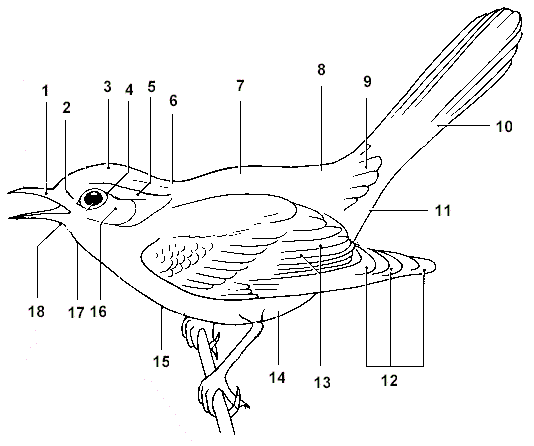How to Identify Birds
The ability to effectively ID birds takes many years of practice. However, there are several strategies you can use that will help you identify almost any bird. The first thing you must do is familiarize yourself with the topography of a bird or its field marks. Most birds have at least one field mark that is unique to them. Below is a diagram of a bird's basic field marks.
|
| 1) Bill or beak 2) Lore 3) Crown 4) Eye ring 5) Eye stripe 6) Nape 7) Back 8) Rump 9) Upper tail coverts 10) Tail feathers 11) Under tail coverts 12) Primary flight feathers 13) Secondary flight feathers 14) Flank 15) Breast 16) Cheek 17) Throat 18) Chin |
Next familiarize yourself with a field guide to birds.
National Geographic's Field guide to North American Birds is great choice
(assuming you are in North America). After you are familiar with a bird's
field marks and a field guide, you are ready to ask a series of simple questions
which will narrow down your choices.
- Where did you see the bird or What is its HABITAT? There are special environments, distinctive vegetation, landforms, and specific climates that birds inhabit. Some birds can use a wide variety of habitats and some birds have a very specific habitat? For example woodpeckers often forage on and nest in large standing dead trees (snags). You would not expect to see a woodpecker probing for insects on the beach.
- How big is the bird? There are basically 7 size categories: very small, sparrow-sized, robin-sized, pigeon-sized, crow-sized, goose-sized, and very large.
- How is it acting or what is its BEHAVIOR? (dependent on habitat) In water - how did it swim, dive, land? On land - was it head bobbing, wing flashing, walking/running? In flight - was it soaring, flapping, rapid/slow, erratic/in formation?
- What is its SHAPE & POSTURE? Stocky vs. slender. What is the shape of the bill, wings, tail, legs, head, and neck?
- What is its COLOR & PATTERN? Does it have wing bars, spots, eye lines, eye rings, etc? This is where knowing field marks comes in handy.
- Finally, What did it sound like? Most species can be identified by their song or call. However, this skill can also take many years to develop.
If you would like to practice these skills go to the common birds of Atlanta page. Click on the bird names and you can view a picture, play the song or call, and read about each bird's field marks and habitat.
